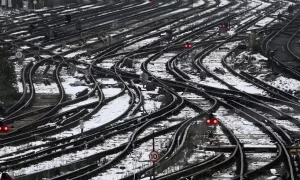
Train strikes, a cold snap and snowy conditions have kept workers and shoppers from city centres this week, emptying out high streets and office buildings, figures show.
Footfall on Britain’s high streets and at shopping centres plunged on Tuesday morning as consumers stayed at home, according to research by the retail data analysts Springboard.
Separately, office occupancy data showed that fewer workers made it to their desks across the UK on Monday in the face of snowy conditions, but levels attending slipped even further on Tuesday as rail strikes kept many working remotely.
London was particularly affected by the decision by office workers and shoppers to stay at home.
The two-day rail strike on Tuesday and Wednesday is the first in a wave of industrial action that will affect train travel for four weeks around Christmas. Only about 20% of normal services were expected to run during the strike involving about 40,000 members of the RMT union at Network Rail and 14 train operators, according to Network Rail.
Footfall at shops close to offices in central London was nearly 37% lower on Tuesday than the same day in 2019, Springboard found, while across the UK as a whole, it was 26%.
High streets across Britain also had much lower visitor numbers on Tuesday, with footfall down a third on the same day three years ago. Coming during the crucial pre-Christmas trading period, other types of retail locations were also affected. Footfall was nearly 28% lower at shopping centres, and was down 9% at retail parks.
Diane Wehrle, the insights director at Springboard, said: “The impact on retail and hospitality businesses in what is a critical trading time of the year, less than two weeks before Christmas, will undoubtedly be severe and could mean failure for some.”
Meanwhile, UK offices were considerably quieter on Monday, averaging 24% occupancy, which was 8% lower than the same day a week earlier, according to data from Freespace, a workplace technology company that tracks building occupancy levels.
Occupancy levels remained low on Tuesday, which is now one of the busiest days of the week in city centre offices, after rail passengers were advised not to travel during the strike.
Average UK office occupancy fell to 28%, down by more than two-fifths on the 47% level a week earlier. London offices were even quieter, reaching just 22% occupancy, less than half the 51% seen on the same day a week earlier.
However, the rise of remote working and video conferencing during the pandemic has enabled office workers to carry out their roles even if they are not able to reach their usual workplace.
“The acceptance of new working patterns has given everybody a newfound freedom to work where they want and how they want; to move the dial between independent and collaborative working as needed,” said Raj Krishnamurthy, the chief executive of Freespace.
Read more:
UK shoppers and workers kept home by rail strikes and cold snap






